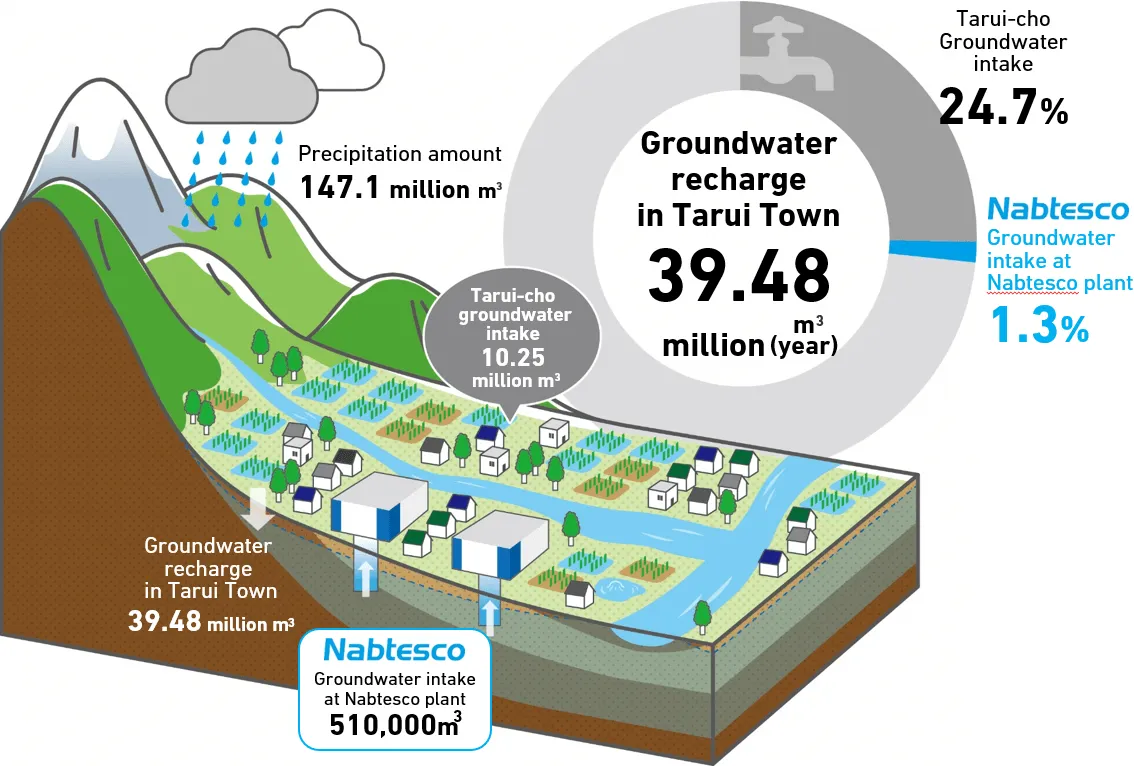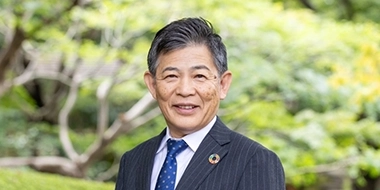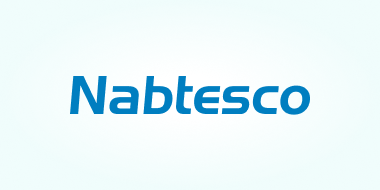
Conservation of Water Resources and Biodiversity
Basic Approach and Policy
Basic Approach to Water Resources
Although the Nabtesco Group does not currently require a large amount of water nor water of a certain quality for its business operations, we consider the management of water resources to be an important issue for environmental conservation and are working to reduce water consumption, properly manage water quality, and prevent the outflow of water pollution substances.
The amount of water used and discharged at each base are measured every month, and the Group data are accumulated using the environmental information management tool. As for bases where the amount of water per month fluctuates greatly, we conduct surveys to identify contributing factors for the increased water usage, and implement measures to reduce the water use as necessary. As for water quality control, we continuously monitor through monthly voluntary tests and regular inspections by external experts.
In addition, we work on controlling global water usage, including that of overseas group companies Although water usage at our overseas group companies is only 10% of the usage of the Nabtesco Group as a whole, we will continue to implement controls in order to address global water risks.
There were zero violations of laws and regulations at domestic and overseas sites in FY2024. In the future, we will continue to further tighten control over water use.
The Nabtesco Group has collaborated with external initiatives to reduce water usage, responding to CDP Water* since FY2014.
*CDP Water is a CDP program that asks companies about risk awareness and response strategies regarding water risk.
Measures
The Nabtesco Group uses groundwater mainly to cool test stands and melt snow in snowy regions (Yamagata and Gifu).
- Water quality management:
- We discharge used groundwater to rivers based on the strict water quality control criteria set by the Group.
- Reduction of water withdrawal:
- We are halving the cooling water usage for air conditioners by installing high-efficiency air conditioning equipment. Additionally, we are working to reduce water consumption by recycling the cooling water used for testing equipment.
We will continue to make efforts to improve water use.
Targets and Results for the Fiscal Year
The total volume of water used by the Nabtesco Group in FY2024 amounted to 519,000 ㎥, showing a significant decrease from the previous year. Through efforts to recycle water used in plant facilities, the unit sales value in FY2024 was 1.61, greatly surpassing the target of 1.85. The mid-term target set for 2024 had already been achieved ahead of schedule in 2022.In FY2025, the Nabtesco Group established a new mid-term target with FY2027 as the target year. We aim to reduce water withdrawal per unit of sales by 4.3% compared with FY2023.
Due to heavy rainfall caused by recent climate change, the risk of rainwater flooding our plants is increasing. The Nabtesco Group uses both oil-based and water-soluble cutting fluids in its business operations and recognizes the risk that, if rainwater enters the manufacturing facilities, oil and chemical substances may flow into rivers. To prevent this, we are making capital expenditures to install oil-water separation tanks and oil recovery equipment.
In FY2024, we spent ¥43.7 million to strengthen rainwater drainage capacity and implement waterproofing measures for buildings.
Target of Water Use Activities and FY2024 Results
| Item | Targets | FY2023 results (Unit: ㎥/one million yen) |
Status | |
|---|---|---|---|---|
| Targets (Unit: ㎥/one million yen) |
Target year | |||
| Global water use (Amount per unit of sales) |
1.85 or below (2023 actual results) | 2024 | 1.61 | Achieved |
| 2.45 or below (2020 actual results) | 2022 to 2024 (Mid-term target) | Achieved | ||
- *For the scope of data collection, please refer to “Scope of Environment and Other Data (Excel 21.5 KB).”
- *Data is examined by LRQA Limited with a view to ensuring the reliability of the calculated data.
Global Water Intake Amount
Global Wastewater
Addressing Water Risks
Every year, the Nabtesco Group evaluates the water risks posed to its major sites using the Aqueduct tool provided by the World Resources Institute and in reference to the “water vision” announced by the local municipalities. Based on the evaluation results obtained in FY2024, eight sites in China and two in Thailand out of 36 sites have high water risks. However, our facilities outside Japan exclusively utilize tap water, without drawing from underground sources or rivers. Also, the total amount of water used at the sites is minimal and so the impact of the water risks on Nabtesco is limited. Going forward, we will control the risks through ESH audits and monitoring of laws and regulations.
In addition, to further promote action on water risks through the supply chain, we are conducting surveys on water use (water intake, wastewater, water quality, etc.) of Tier-1 suppliers in Japan and overseas, and evaluation of water risks using AQUEDUCT. Each supplier is analyzed and evaluated, with the results provided in the form of written feedback. We also visit specific suppliers directly and conduct interviews at web conferencing. This serves to enhance communication with suppliers while supporting knowledge sharing regarding environmental management and improved environmental stewardship. As well as engaging with suppliers, we actively participate in environmental and water related regional councils, exchanging information and conducting activities related to water conservation in order to maintain harmony with the local community.
Risk Assessment on Groundwater Use
The Nabtesco Group does not currently require a large amount of water or a certain quality of water in its business operations. However, some offices pump groundwater from a well on their premises for use. Due to this, in FY2020, the Group also investigated the impact of the use of groundwater to the water resources in the area. First, the Group performed an investigation in the Gifu Region, where the quantity of groundwater used is large. The investigation results show the Tarui Plant (for hydraulic equipment) and Gifu Plant (for aircraft equipment) of Nabtesco in the Gifu Region do not place a large burden on the groundwater resources of Tarui-cho.

The plants will monitor usage to not impact the area, in order to sustain the valuable environment over many years, while still using groundwater going forward.
Comment from an expert familiar with groundwater in Gifu Prefecture
Tarui-cho is blessed with a rich groundwater environment, where you can find spring water and a healthy population of smallhead sticklebacks (Gasterosteus microcephalus) who live there. It is also an important recharge area for the Nobi Plain. Nabtesco, which uses groundwater in Tarui-cho, cares about its impact of its business operations on the downstream area, and quantifiably assessed the groundwater and surface water circulation in the area. It is a very meaningful initiative. In order for us to enjoy the benefits of groundwater into the future, I hope Nabtesco will promote the conservation of the groundwater environment together with residents, based on the results of the assessment.
Professor Kohji Kamiya,
Department of Civil Engineering,
Gifu University
In addition to the Tarui Area, Nabtesco actively participates in regional councils related to the environment and water, and engages in water conservation activities and information exchange to harmonize with the local community.
| Name | Area |
|---|---|
| Hyogo Environmental Conservation Liaison Committee | Kobe |
| Kobe District Environmental Conservation Liaison Council | Kobe |
| Toban Regional Groundwater Useage Measure Council | Kobe |
| Gifu Prefecture Environment Promotion Association | Gifu |
| Seino Area Groundwater Useage Measure Council | Gifu |
Biodiversity Conservation
The Nabtesco Group evaluated the impact of its business activities on biodiversity by using an external tool, namely the SBTN Sectoral Materiality Tool*1. As the first step for the evaluation, we carried out a screening to identify the materiality of the impact on biodiversity of the sectors to which our businesses are related. As a result of performing the analysis by defining the pressure categories given the score of “Medium” or higher as “material pressure categories,” we found out that all our Group’s businesses needed to be assessed in more detail.
At the same time, to evaluate both the dependence and impact of our businesses on natural capital, we used the WWF Biodiversity Risk Filter*2. In terms of dependence, all of our businesses were assessed as “High” or above for water availability, and those related to construction materials were rated “High” for wood availability. In terms of impact, our manufacturing-related businesses were assessed as “Very High” for pollution, while businesses related to construction materials were rated “High” or above for land use change, exploitation, resource depletion, and media scrutiny.
Next, using the WWF Biodiversity Risk Filter*2, we conducted detailed assessments according to the locations of our business sites. In terms of dependence, some sites were assessed “High” for risks related to water and air; however, since our operations do not require large volumes or specific quality of water and air, we regard the risks as low. Many sites were assessed “High” or above for risks such as landslides, fires, heat waves, and tropical cyclones, which we will work to mitigate through climate change countermeasures. In terms of impact, two construction-material-related sites were assessed as having a high risk of contributing to deforestation and pressures on biodiversity; however, as these sites mainly handle stainless steel and similar materials, the actual risk is considered low.
We also conducted similar evaluations for our supply chain. We assessed major suppliers accounting for 1% or more of our annual procurement value, as well as top customers in our seven core businesses. As a result, many suppliers and customers were assessed “High” or above for risks such as landslides, heat waves, and tropical cyclones, which we will mitigate by advancing climate change measures across our entire supply chain, both upstream and downstream. In terms of impact, some major customer sites (in China) were assessed as having a medium level of risk.
In addition, we conducted an assessment using the Integrated Biodiversity Assessment Tool (IBAT)*3. Within a 50 km radius of our sites, we identified proximity to areas inhabited by endangered species on the IUCN Red List and to Key Biodiversity Areas (KBA)*4. In Japan, where we have major production sites, we confirmed 75 species classified as Critically Endangered (CR), 666 species as Endangered (EN), and 538 species as Vulnerable (VU). In other regions, we confirmed 71 CR species, 342 EN species, and 529 VU species. The number of KBAs confirmed was 57 in Japan and 56 in other regions.
We will work continuously for biodiversity conservation while advancing our impact assessment method.
- *1 Tool to assess the impact on biodiversity provided by the Science Based Targets Network (SBTN). Users of the tool can assess the materiality of impacts on a six-point scale for the selected business activities (sectors) and pressure categories.
- *2 Impact assessment tool provided by the World Wide Fund for Nature (WWF). Users of this tool can assess biodiversity-related global risks based on the use of 50 or more biodiversity-related dataset groups.
- *3 Integrated Biodiversity Assessment Tool (IBAT) for biodiversity evaluation.
- *4 Key Biodiversity Area, globally important sites for biodiversity.



